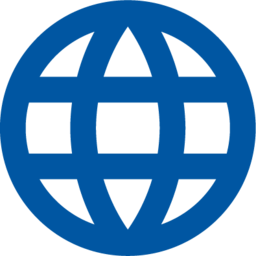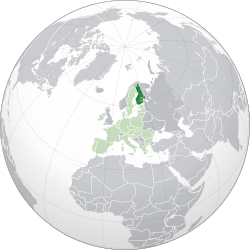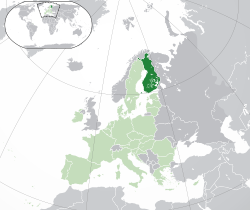 Global Information
Global InformationFinland information
Republic of Finland
| |
|---|---|
 Flag
 Coat of arms
| |
| Anthem: Maamme (Finnish) Vårt land (Swedish) (English: "Our Land") | |
  Location of Finland (dark green) – in Europe (green & dark grey) | |
| Capital and largest city | Helsinki 60°10′15″N 24°56′15″E / 60.17083°N 24.93750°E |
| Official languages |
|
| Recognized national languages |
|
| Ethnic groups (2021)[1][2] |
|
| Religion (2021)[3] |
|
| Demonym(s) |
|
| Government | Unitary parliamentary republic[4] |
• President | Alexander Stubb |
• Prime Minister | Petteri Orpo |
• Speaker of the Parliament | Jussi Halla-aho |
| Legislature | Parliament |
| Independence from RSFSR[5] | |
• Establishment of Grand Duchy of Finland under the rule of Russian Empire | 29 March 1809 |
• Declaration of full independence | 6 December 1917 |
• Finnish Civil War | January – May 1918 |
• Constitution established | 17 July 1919 |
• Winter War | 30 November 1939 – 13 March 1940 |
• Continuation War | 25 June 1941 – 19 September 1944 |
• Joined the EU | 1 January 1995 |
• Joined NATO | 4 April 2023 |
| Area | |
• Total | 338,145[6] km2 (130,559 sq mi) (65th) |
• Water (%) | 9.71 (2015)[7] |
| Population | |
• 2023 estimate | |
• Density | 16.4/km2 (42.5/sq mi) (213th) |
| GDP (PPP) | 2023 estimate |
• Total | |
• Per capita | |
| GDP (nominal) | 2023 estimate |
• Total | |
• Per capita | |
| Gini (2023) | low |
| HDI (2022) | very high (12th) |
| Currency | Euro (€) (EUR) |
| Time zone | UTC+2 (EET) |
• Summer (DST) | UTC+3 (EEST) |
| Date format | dd.mm.yyyy[12] |
| Driving side | right[13] |
| Calling code | +358 |
| ISO 3166 code | FI |
| Internet TLD | .fi, .axa, .eub |
| |
Finland,[a] officially the Republic of Finland,[b][c] is a Nordic country in Northern Europe. It borders Sweden to the northwest, Norway to the north, and Russia to the east, with the Gulf of Bothnia to the west and the Gulf of Finland to the south, opposite Estonia. Finland covers an area of 338,145 square kilometres (130,559 sq mi)[6] and has a population of 5.6 million. Helsinki is the capital and largest city. The vast majority of the population are ethnic Finns. Finnish and Swedish are the official languages, with Swedish being the native language of 5.2% of the population.[14] Finland's climate varies from humid continental in the south to boreal in the north. The land cover is predominantly boreal forest biome, with more than 180,000 recorded lakes.[15][16]
Finland was first settled around 9000 BC after the last Ice Age.[17] During the Stone Age, various cultures emerged, distinguished by different styles of ceramics. The Bronze Age and Iron Ages were marked by contacts with other cultures in Fennoscandia and the Baltic region.[18] From the late 13th century, Finland became part of the Swedish Empire as a result of the Northern Crusades. In 1809, as a result of the Finnish War, Finland was captured from Sweden and became a Grand Duchy of Finland, an autonomous state ruled by the Russian Empire. During this period, Finnish art flourished and the idea of full independence began to take hold. In 1906, Finland became the first European state to grant universal suffrage, and the first in the world to give all adult citizens the right to run for public office.[19][note 2] Following the Russian Revolution of 1917, Finland declared its full independence. In 1918 the young nation was divided by the Finnish Civil War. During World War II, Finland fought against the Soviet Union in the Winter War and the Continuation War, and later against Nazi Germany in the Lapland War. As a result, it lost parts of its territory but retained its independence.
Finland remained a largely agricultural country until the 1950s. After World War II, it industrialised quickly and established an advanced economy, with a welfare state built on the Nordic model. This allowed the country to experience overall prosperity and high per capita income.[20] During the Cold War, Finland officially embraced a policy of neutrality. Since then, it has become a member of the European Union in 1995, the Eurozone in 1999, and NATO in 2023. Finland is a member of various international organisations, such as the United Nations, the Nordic Council, the Schengen Area, the Council of Europe, the World Trade Organization, and the Organisation for Economic Co-operation and Development (OECD). The nation performs exceedingly well in national performance metrics, including education, economic competitiveness, civil liberties, quality of life, and human development.[21][22][23][24]
Cite error: There are <ref group=note> tags on this page, but the references will not show without a {{reflist|group=note}} template (see the help page).
- ^ "11rv – Origin and background country by sex, by municipality, 1990–2020". Statistics Finland. Archived from the original on 1 June 2022. Retrieved 21 August 2021.
- ^ "United Nations Population Division | Department of Economic and Social Affairs". United Nations. Retrieved 29 June 2018.
- ^ "Population". Statistics Finland. Retrieved 5 April 2021.
- ^ Cite error: The named reference
Parliamentarywas invoked but never defined (see the help page). - ^ The Soviet Russia's recognition of Finland's independence Dec. 1917 - Jan. 1918, retrieved 22 February 2024}
- ^ a b "Finland". Central Intelligence Agency. 8 August 2023 – via CIA.gov.
- ^ "Surface water and surface water change". Organisation for Economic Co-operation and Development (OECD). Retrieved 11 October 2020.
- ^ "Immigration record high in Finland in 2023". Statistics Finland. 25 January 2024. Retrieved 25 January 2024.
- ^ a b c d "World Economic Outlook Database, October 2023 Edition. (Finland)". IMF.org. International Monetary Fund. 10 October 2023. Retrieved 11 October 2023.
- ^ "Gini coefficient of equivalised disposable income". Eurostat. Retrieved 14 March 2024.
- ^ "Human Development Report 2023/24" (PDF). United Nations Development Programme. 13 March 2024. p. 279. Retrieved 14 March 2024.
- ^ Ajanilmaukset Archived 20 October 2017 at the Wayback Machine Kielikello 2/2006. Institute for the Languages of Finland. Retrieved 20 October 2017
- ^ Switched to right side since 1858 Roads' safety: DRL Finland 1970 - History Book
- ^ "Språk i Finland" [Language in Finland]. Institute for the Languages of Finland (in Swedish).
- ^ Li, Leslie (16 April 1989). "A Land of a Thousand Lakes". The New York Times. Retrieved 20 September 2020.
- ^ Mansel, Lydia (15 November 2023). "15 Best Places to Visit in Finland, From the Sauna Capital of the World to Santa Claus Village". Travel + Leisure. Retrieved 2 January 2024.
- ^ Haggren, Georg; Halinen, Petri; Lavento, Mika; Raninen, Sami; Wessman, Anna (2015). Muinaisuutemme jäljet. Helsinki: Gaudeamus. p. 23. ISBN 978-952-495-363-4.
- ^ Haggren, Georg; Halinen, Petri; Lavento, Mika; Raninen, Sami; Wessman, Anna (2015). Muinaisuutemme jäljet. Helsinki: Gaudeamus. p. 339. ISBN 978-952-495-363-4.
- ^ Parliament of Finland. "History of the Finnish Parliament". eduskunta.fi. Archived from the original on 6 December 2015.
- ^ "Finland". International Monetary Fund. Retrieved 17 April 2013.
- ^ "Finland: World Audit Democracy Profile". WorldAudit.org. Archived from the original on 30 October 2013.
- ^ "Tertiary education graduation rates—Education: Key Tables from OECD". OECD iLibrary. 14 June 2010. doi:10.1787/20755120-table1 (inactive 31 January 2024). Archived from the original on 30 April 2011. Retrieved 6 March 2011.
{{cite journal}}: Cite journal requires|journal=(help)CS1 maint: DOI inactive as of January 2024 (link) - ^ "Her er verdens mest konkurransedyktige land—Makro og politikk". E24.no. 9 September 2010. Archived from the original on 14 October 2010. Retrieved 6 March 2011.
- ^ "The 2009 Legatum Prosperity Index". Prosperity.com. Archived from the original on 29 October 2009. Retrieved 4 February 2010.
Cite error: There are <ref group=lower-alpha> tags or {{efn}} templates on this page, but the references will not show without a {{reflist|group=lower-alpha}} template or {{notelist}} template (see the help page).